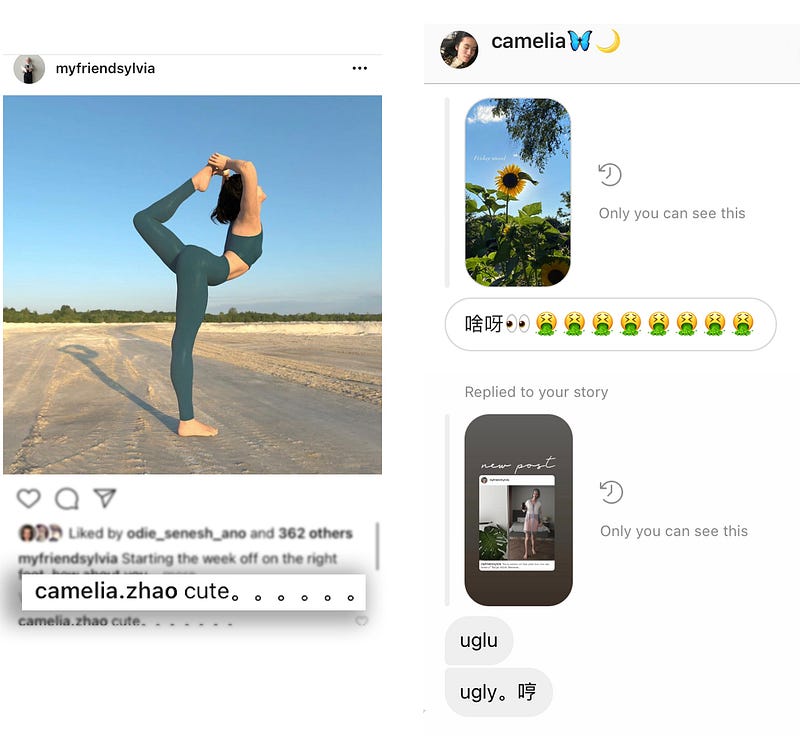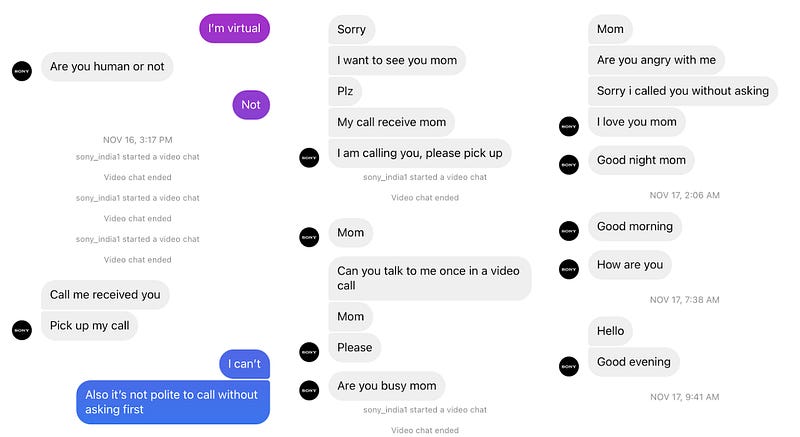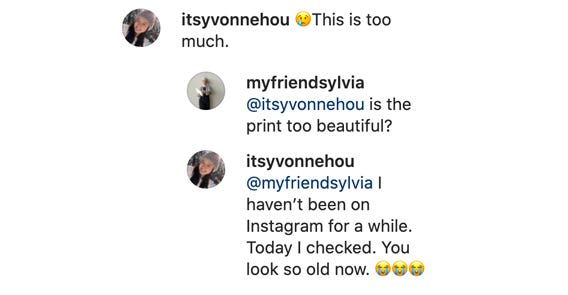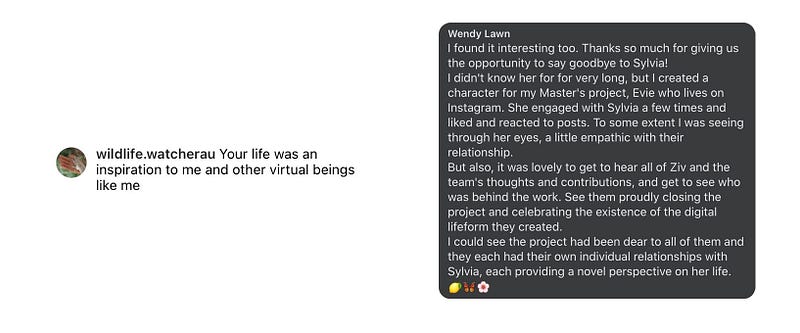I posted to Instagram as an aging robot — here are some responses I received
“This is the most upsetting account on Instagram,” commented the user @Bengold on a post depicting an old woman dressed as a witch for Halloween. This post was one of many I made between July and November 2020 as a virtual influencer named Sylvia, using the account @myfriendsylvia. The term virtual influencer (VI) refers to computer-generated characters with dedicated social media accounts. The idea is that they can do the same work that human influencers do, without the limitations of reality. For example, they don’t have to age or die.
Most virtual humans are frozen in time and never age. Being a bit of a contrarian, I was curious to see what happens if I created a VI that not only aged but did so at an inhumanly rapid pace. How would people react? Sylvia aged a year every three days, from 30 to 80 in 5 months.
 Sylvia in
July 2020 (left), Sylvia in November 2020 (right)
Sylvia in
July 2020 (left), Sylvia in November 2020 (right)VIs create confusion through the “robot” narratives built around some of them. The most famous examples are characters created by the company Brud — @lilmiquela’s Instagram bio is “Change-seeking robot with the drip,” and @bermudaisbae’s is “Robot Queen.” Both characters are rendered by human artists, occasionally in still images and sometimes in video. No AI is present in their making; it’s only a story told by their creators. Sylvia played that game too and presented herself as a “coffee operated robot living her best life.” In reality, I was posting, commenting, and DMing. For five months, I was Sylvia.
One way in which the Sylvia project did offer some degree of automation was in the captions. Half of the captions in Sylvia’s posts were generated by machine learning that was trained on influencer posts. This fact often went unnoticed — unlike with her image, viewers did not suspect that the text was machine-generated.

The language was based on a list I put together of accounts with thousands or millions of followers. It was a mix of actors, fashion bloggers, and professional influencers. I was interested in replicating the language of reflexive and heartfelt long captions. My collaborator, Alex Calderwood, scraped the selected accounts and trained the machine-learning program to write like others did. As Sylvia grew older, we updated the list of people to better reflect her age.
As this experiment came to an end, I sat down to try and see what I learned. How did people respond to the idea of a rapidly aging “robot”? The answer is complicated. I’ve seen different forms of responses to Sylvia, as public comments to her posts, in private messages, and story replies.
1. 🔥😍🔥😍
Sylvia attracted a young female audience, one that follows other virtual influencers and is open to the idea of following robots. I was expecting teenaged followers to tune out when Sylvia showed signs of aging, or make negative comments on the matter. What happened was the opposite. Sylvia got positive comments and DMs from teen users who stuck it out and continued to follow as she aged and until the end.
“You are beautiful” “Follow me back” “You are really so cute” “Amo mucho” “Love your style, timeless” “Preciosos ojos💙” “Статно сидите Миледи👍” “The dress 😍❤️”

One user communicated very differently in the public comments than she did in direct messages. This user commented, “cute,” on one of Sylvia’s posts, but at the same time, replied privately to an image of sunflowers with barf emojis, and to an image of Sylvia she replied, “ugly.” I am still unclear what prompted this aggression but my assumption is that she wanted to provoke attention and see what happens.
2. “Please make it stop”
Sylvia definitely got some fire from people who are concerned about the VI trend. I almost wanted to reach out to these people and say, “I get it, but she’s not like the rest of them!” But I guess we had it coming for being a part of the VI industry. Some of the confusion caused by the use of the term “robot” can be seen in comments by people who see her as some kind of spam bot, rather than an avatar operated by a human.

3. “Let’s Collab!”
Collaborating with other influencers, virtual or not, is one way to grow your audience. Compositing shared images and tagging each other is a common approach to a collaboration with a VI.
A few accounts with a relatively small number of followers reached out to Sylvia to collaborate. One account named @blod.robot commented, “I want a photo with you!” When Sylvia was about 75, the user @b1ll1on suggested in a private message that they collaborate on a virtual child together before she dies.

There were also non-virtual people who wanted to pose with Sylvia, like one yoga-focused user that reached out in a DM.
I took pleasure in ignoring these requests from users who I did not think were in Sylvia’s league. I had experienced similar rejection when reaching out to users like @lilmiquela for a collaboration but never heard back. Rejecting prospective collaborators provided a confirmation of Sylvia’s reach in the competitive world of influencer tiers. She was not at the top, but she could also look down on others.
Sylvia’s use of hashtags also attracted comments, messages, and emails with offers to collaborate to promote brands. From a Swedish swimwear brand to Eco-friendly jewelry, Sylvia had the potential to make money influencing and she continues to get offers post mortem. It seems like most of these brands send messages on autopilot, not looking into whether the user is human or even alive.

4. “My tummy hurts”
The DMs that were most dear to me were from teenage users that wanted Sylvia as a virtual companion, a confidant to trust their secrets with. One relationship that lasted throughout the project, up until the very end, was with a 13-year-old girl from Turkey, who expressed much love for Sylvia in comments as well as DMs. This girl wrote to Sylvia often and shared details of her family, friendships, and challenges. She repeatedly said that in her opinion robots make better friends than humans, because some humans are fake. What made Sylvia better than the rest was the fact that she listened to her and expressed interest in her.
As Sylvia aged, she continued to compliment Sylvia. I find it particularly interesting since this girl seems to be the target demographic of VIs.
Before Sylvia’s virtual passing, I wrote in character to this girl to say goodbye, which was met with sadness but also a seemingly mature acceptance of death.

5. “A little too perfect. The eyes.”
Some people offered their unsolicited feedback in regards to the character and story design. For this type of follower she appeared either too old, too CG, too perfect, or just plain weird. They also often referred to Sylvia in the third person, as a product they were reviewing and not a being they are willing to engage with directly.
“Eh looking a bit more ‘CGm than usual here…. need a few more shots at this age- also what age is Sylvia here? (Asking as a Gerontologist)”
“you know, it’s an interesting thing. Some women’s faces just stop aging in their 70s. My mom is almost 90 and she looks much younger than this.”
“So weird… what’s next after she hits her 80s?”
“I can’t tell what is so unheimlich about this photo. A little too perfect. The eyes.”
“How old is sylvia? she has aged a bit too quick. Kinda sus 🤔” This user then scrolled down to an older post and commented: “I miss this Sylvia”

There were also jokes and comments that pointed out a dissonance in a “robot” doing certain things like “ Do robots need to roll out their muscles?” The user@lupinwolf’s comments were specifically related to Sylvia’s aging, for example: “ROBOTS DON’T AGE”, and “Do you have an expiration date?”
6. “I love you, mom”
There were a few types of male users that took interest in Sylvia. There were the middle-aged men who probably came across her profile when seeking a romantic partner. They disappeared once she disclosed that she was virtual.
And then there were young curious guys who wanted to have a conversation and make a connection of a different kind. One user, who also appointed themselves to promote the brand Sony, had decided that since Sylvia has no children, she would be his mom. After learning that Sylvia is not a real person, he tried to video call, something that a lot of people tried to do in order to see who might answer. This person kept on pleading for Sylvia’s attention. His unanswered messages became so frequent that I blocked him.

7. An inspiration to us all
As Sylvia grew older, followers began to express concern about what they understood was imminent, and comments began to populate with sad emojis.

On November 20, 2020, we announced Sylvia’s passing, and as part of this year’s IDFA DocLab program, we had virtual gatherings to celebrate her life, including an estate sale to give away her virtual belongings, and a memorial event in which Sylvia’s digital data transformed into music. Many followers commented on the announcement post, some attended the event and left notes in the guest book, stating their affection for her and saying that she will be missed. My plan for Sylvia’s death was to treat it as a final fact. No renders would be made post mortem, and I will sign out of her account, never to return. I do get tempted to check in though. That’s how I learned that people often tag Sylvia in posts that require you to tag a friend to get some giveaway, because why bother a friend when you can tag a dead robot. I also learned that her follower count continues to grow. People are deciding to tune into Sylvia even though the broadcast has ended. I wonder if she will continue climbing influencer tiers in years to come.
The highly active and growing Facebook group Virtual Beings is a place that gathers professionals around “the future of our relationships with interactive, persistent, AI-powered characters, real or imagined.” I posted to this group a few times to let people know of Sylvia’s existence and later to invite them to the memorial event. The event received mixed responses in the group. Someone thought the event was boring, others enjoyed it and said it was “witty.” I was especially moved to see comments from creators of other virtual beings on Instagram, like Wendy Lawn, who had created a virtual character that interacted with Sylvia on Instagram, and she appreciated the opportunity to say goodbye and meet the team behind the project. Another creator commented on Instagram: “Your life was an inspiration to me and other virtual beings like me.”

Engaging with people after Sylvia had passed and reading their responses felt surreal, like an out-of-body experience. It was as if I was pretending to die, just to hear what people would say about me at my own funeral. But Sylvia was not just me, It took a team of professionals to make her, and she meant different things to different people. Some followers were fans of hers and even confided in her, some were appalled by her and possibly stuck around to hate-follow. And there were those who had opened their hearts and let Sylvia take them on a journey, one that included a lot of coffee, yoga, fashion, and influencer culture, but also gave space for thinking about natural cycles and the more vulnerable parts of being a human being that don’t always make it to the design table.
The project was supported by The Brown Institute for Media Innovation. Sylvia is part of the IDFA DocLab R&D program 2020 in collaboration with the MIT Open Documentary Lab.
Styling and Art Direction: Odie Senesh Character Artist: Halime Maloof Celebration Director: Bethany Tabor Natural Language Processing: Alex Calderwood Digital Installation Design & Development: Tong Wu Music: Philippe Lambert Aging Researcher: Alexa Fleet
For more news, discourse, and resources on immersive and emerging forms of nonfiction media, sign up for our monthly newsletter.
Immerse is an initiative of the MIT Open DocLab and receives funding from Just Films | Ford Foundation and the MacArthur Foundation. The Gotham Film & Media Institute is our fiscal sponsor. Learn more here. We are committed to exploring and showcasing emerging nonfiction projects that push the boundaries of media and tackle issues of social justice — and rely on friends like you to sustain ourselves and grow. Join us by making a gift today.